Sikandra Bagh is now, a relatively small monument of Lucknow, the city of Nawabs. It was built by the last Nawab of Awadh, Wajid Ali Shah as a summer house, then, on the banks of river Gomti. It was a cultural hub of the city. He named it after we one of his Begums, Begum Sikandra. Surprisingly the Queen of this place emerged to be someone, who, herself would have not realized how and why history would remember her.

Architectural Magnificence of Sikandra Bagh
The entrance to Sikandra Bagh has a unique “pair of fish” design typical of the Nawabs. The monument has a peculiar, hybrid resonance that has distinctive features of Chinese, European and Persian architectural brilliance in the form of pediments, arches, domes, pagodas and Corinthian pillars assembled at one place.
The Sikandra Bagh complex is said to have housed a summer palace, a wooden pavilion and a small mosque. The palace, in its glory, boasted of three towering gateways on three sides, only one of which now remains. Some delicate art-work can be witnessed on the edges, below the pagodas, and chhattries.
Nawab Wajid Ali Shah specifically bestowed a khillat and offered a robe of honour to his favourite painter Kashi Ram after the completion of the monument. Whatever little that remains of the Sikandra Bagh in the present times, also houses some magnificent frescos with delicate floral designs similar to the renowned Chikan embroidery of Lucknow, believed to have been done by the Nawabi painter, Kashi Ram.
The Roof Design at the entrance of the Monument . The Persian Architecture is there to see

The leftover pillars show how magnificent the Monument would have been in its days of glory. The pillars, unmistakeably have a European touch.
THE UNSUNG QUEEN OF SIKANDRA BAGH
Uda Devi was one of the prominent ‘Dalit Veeranganas’, who participated in the revolt of 1857 against the British East India Company and led one of the fiercest battles in Lucknow which was termed Battle in Sikandra Bagh. She alone killed as many as 32 British soldiers before she died on the battlefield on November 16, 1857.
Early Life:
She was born into a Dalit family in a village in Awadh, present-day Uttar Pradesh. At a young age, she sensed the anger among people against the British administration. She went to Begum Hazrat Mahal, wife of Nawab Wajid Ali Shah to seek help in preparation for the battle against the British. The Begum helped her to form the women’s battalion which Uda Devi led herself. When Awadh was attacked by the British, she along with her husband, became part of the armed resistance.
Role In Independence:
When the British army under the leadership of Commander Colin Campbell attacked Sikandara Bagh in Lucknow, the army had to face a wall of thousands of Dalit women. Many poems were written during that time highlighting the important moments of the battle. One such poem goes like this:
koi unko habsin kehta, koi kehta neech achchut
abla koi unhein batlaye, koi kahe unhe majboot.
(Some called them black African women, some untouchable. Some called them weak, others strong.)
During the battle, Uda Devi received information that her husband, who was a senior warrior in Wajid Ali Shah’s army, had got martyred. As the folklore goes they were planning to start a family, together. When she got the news about her husband she vowed to avenge his death. The love for her motherland fueled by the martyrdom of her beloved husband made her one of those ferocious fighters that made Britishers remember her for a very long time.
Such was her fury and leadership that the Commander-in-Chief of the British Army, Colin Campbell was taken aback by the resistance that his troops faced. He applied all his battle skills to conquer Sikandra Bagh. It was only after using a heavy and huge amount of the ammunition he had that they were able to enter Sikandra Bagh.
On seeing the British army coming towards Sikandra, she climbed a banyan tree disguised as a man and as a sniper killed 32 soldiers of the British army.

Death:
On suspecting a sniper sitting on the tree, commander Colin Campbell ordered soldiers to fire at the tree. It was then that she was shot dead and fell to the ground. The soldiers were surprised when they got to know that a woman had caused such a large number of fatalities.
The magnitude of the battle can be ascertained by the fact that around 2.300 freedom fighters were killed. It is said that more Victoria Crosses were awarded for that single day than ever, many for the assault on the Sikandra Bagh. Uda Devi died a martyr and got buried in history as the Unknown Warrior.
The Queen of Sikandra Bagh got some recognition much much later, thanks to the political nature of India. To attract the Pasi and Dalit votes her statue stands in front of the monument. Neglected and seldom noticed, much like Sikandra Bagh.
-By Narendra Tripathi
trips67@gmail.com
Source: http://www.monumentaltrail.com

About the author:
A corporate Chief Operating Officer. An economist turned historian. Passionate Photographer of monuments.Researcher, Blogger and Traveller. Always on a lookout for forgotten and lesser-known monuments. The stories attached to each monument is the theme of my Blog.




